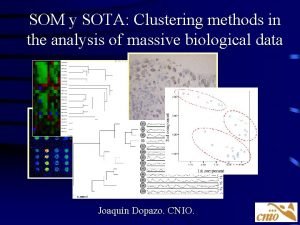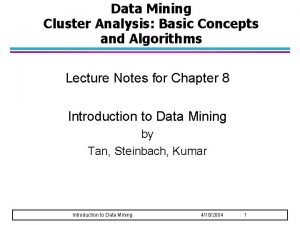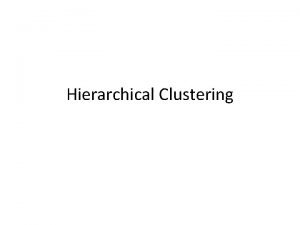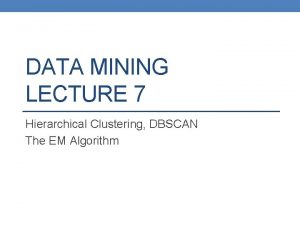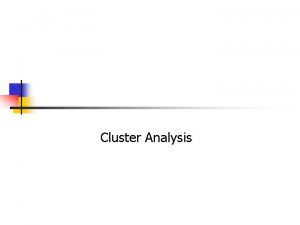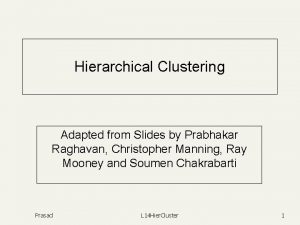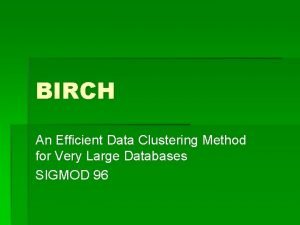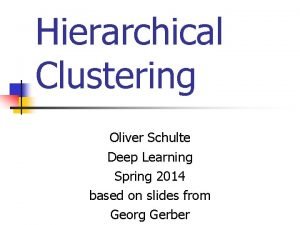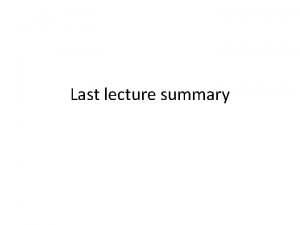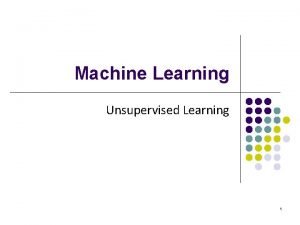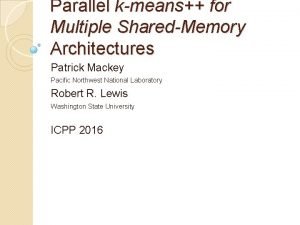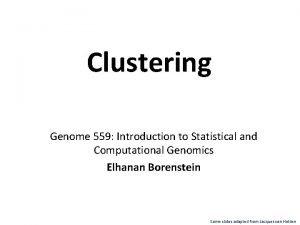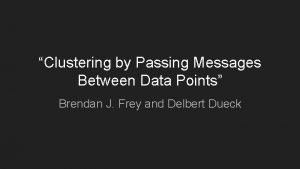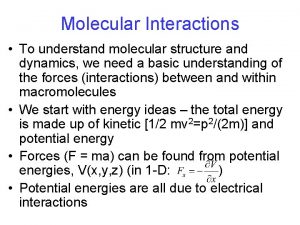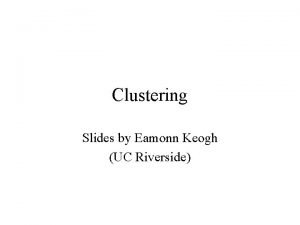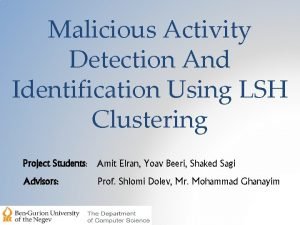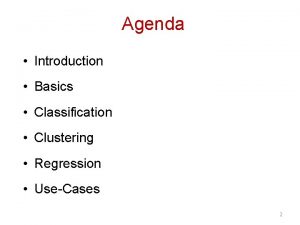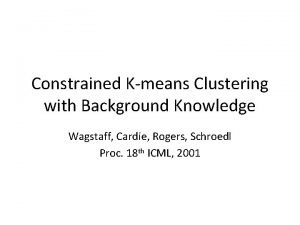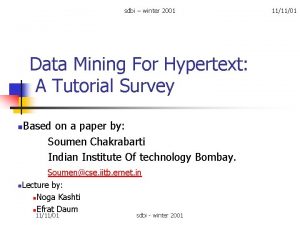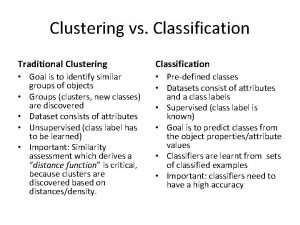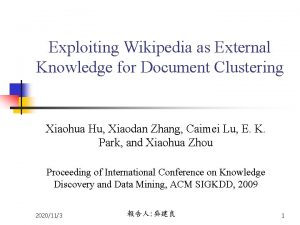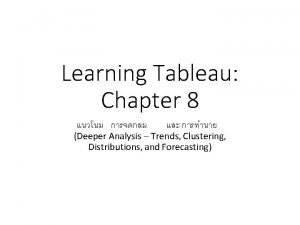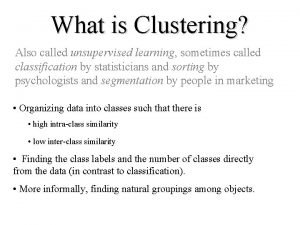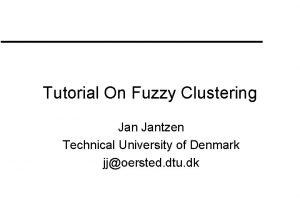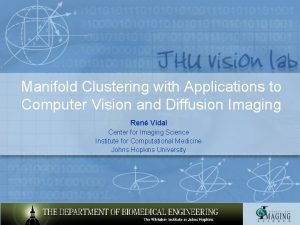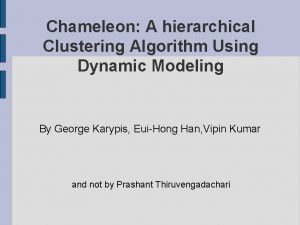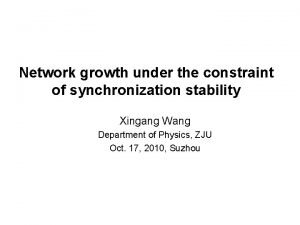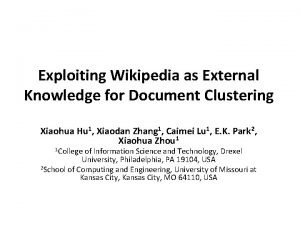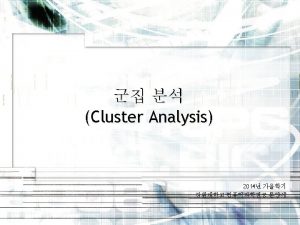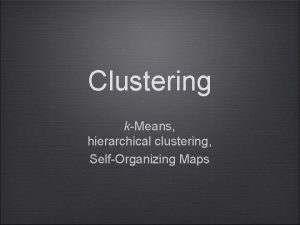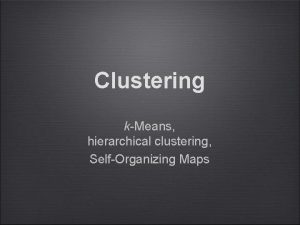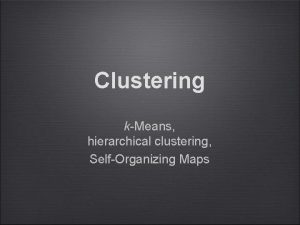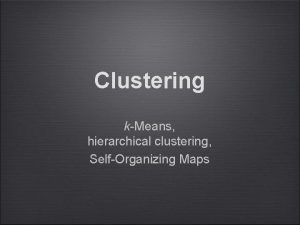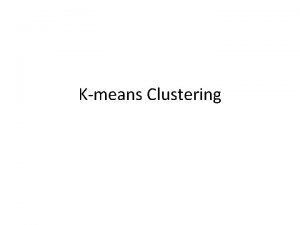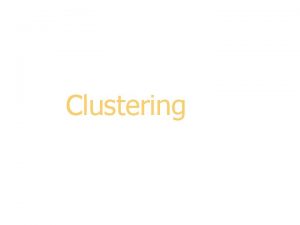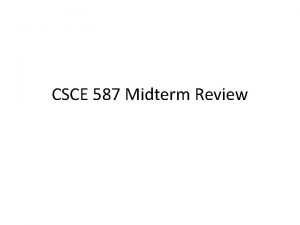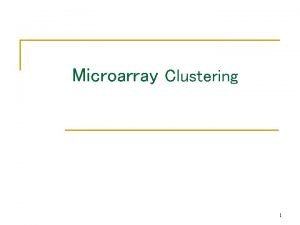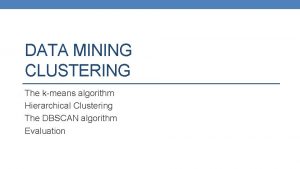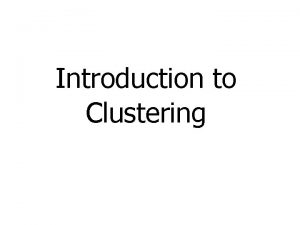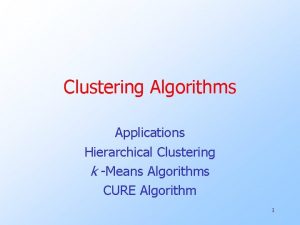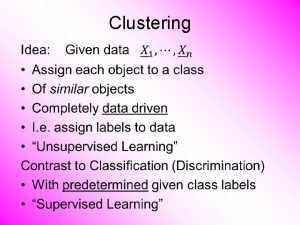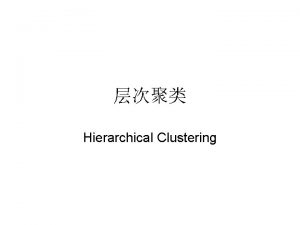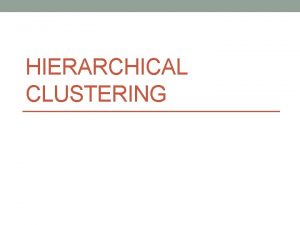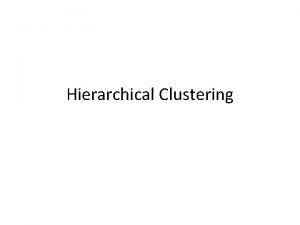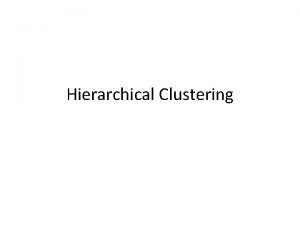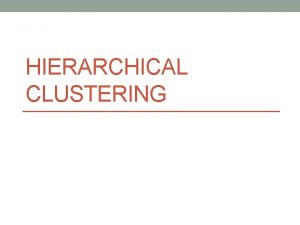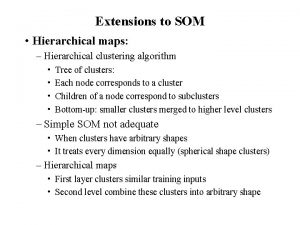Main Clustering Algorithms KMeans Hierarchical SOM KMeans Mac











































- Slides: 43


Main Clustering Algorithms § K-Means § Hierarchical § SOM

K-Means § Mac. Queen, 1967 § clusters defined by means/centroids § Many clustering algorithms are derivatives of KMeans § Widespread use in industry and academia, despite it’s many problems

K-Means Example












Hierarchical Clustering § Starts by assuming each point as a cluster § Iteratively links most similar pair of clusters § User-defined threshold parameter specifies the output clusters

Hierarchical Clustering Variants © In Minitab Linkage Methods Distance Measures § § § Average Centroid Complete Mc. Quitty Median Single Ward Euclidean Manhattan Pearson Squared Euclidean Squared Pearson

Hierarchical Clustering Example

Results

Still There are Problems

Clustering Documents “bag of words” W 1 W 2 W 3. . Wi. . . Wj. . Wn D 1: f 11 f 21 f 31. . fi 1. . . fj 1. . fn 1 D 2: f 12 f 22 f 32. . fi 2. . . fj 2. . fn 2 Dm : f 1 m f 2 m f 3 m. . fim. . . fjm. . fnm § Di: vector of length l § Distance between Di and Dj: <Di, Dj> M

Cluster Centroid § Cluster defined by distance to centroid: C C = 1/m SDi, where m is the # of vectors

Elevations Elevation of D: El(D) = <C, D> Problem: Would like:

Mapping to higher Dimension § Utilizing Kernel Function K(X, Y) = <F(X), F(Y)>, where, X, Y are vectors in Rn, and F is a mapping into Rd, d >> n § Key element in Support Vector Machines § Data needs to appear as Dot Product only: <Di, Dj>

Kernel Function Examples § Polynomial: n K(X, Y) = (<X, Y> + 1) § Feedforward Neural Network Classifier K(X, Y) = tanh(β<X, Y> + b) § Radial Basis K(X, Y) = e-<X, Y>^2/2 s^2

First Step: Penalizing Outliers § Ck = 1/m S(<Di, N(Ck-1)>Di) (1) § Convergence: T l C¥ = Principal Eigenvector of M M, where M is the matrix of Di’s T L l C¥ = lim L ¥(M M) U (2) § Both (1) and (2) are efficient methods of computing C¥

Using Kernels to replace F § Cannot with: l Fk = 1/m S(<F(Di), N(Fk-1)> F(Di)) § Or by using (2): l M= F(D 1) MTM has unmanageable F(D 2) (eventually infinite) dimension. . § So instead we use aik = <F(Di), N(Fk-1)> = (1/m)S(ajk-1<F(Di), F(Dj)>) (3)

Theorem F = Sai*F(Di) , where ai*= lim {ain=(1/m)Sajn-1 K(Di , Dj)} for n ¥ § El(D): Elevation of vector D = Sai*K(Di , D)

Zoomed Clusters § Clusters defined through peaks l Peaks: all vectors, which are the highest in their vicinity: PEAKS = {Dj | El(Dj) ³ (El(Di)<Di, Dj>S) for all i} § S: Sharpening/Smoothing Parameter § Cluster: Set of vectors, which are in the vicinity of a peak

Clustering Example

Zooming Example

Zoomed Clusters Results Default

Clustering Micro. Array Data Experiments Expression Level of Gene i during Experiment j Genes

Micro. Arrays As Time Series

Clustering Time Series § Reveals groups of genes, which have similar reactions to experiments § Functionally related genes should cluster

Simulated Time Series § Simulated 180 Time Series, with 3 clusters and 9 sub-clusters (20 per sub-cluster) § Each time series is a vector with 1000 components l Each component is expression level at a given time

Results Kernel: Polynomial Degree 36 S: 7615

HMM Parameter Estimation Baum-Welch Algorithm Initial HMM Model Refinement of HMM Model Viterbi Algorithm Sequential K -Means Final HMM Model Refinement of HMM Model Final HMM Model

Parameter Estimation with Zoomed Clusters Initial HMM Model Advantages: • Flexibility with number of states • Initial Model is closer to the final one Consequences: • Higher accuracy and faster convergence for either Baum-Welch or Viterbi

Example: Coins Coin 1: 100% Heads Coin 1: 100% Tails Coin 3: 50% Tails 50% Heads HHHHHTTTTTTTHHHHHHHTHTHTTTTTTTT • Regions with similar statistical distribution of Heads and Tails represent the states in the initial HMM Model • Use Elevation Functions, separately for Heads and Tails to represent these distributions

2, Step 3: Create point D in R ipoints Step 4: Cluster all the Step 3: 2: For Calculating 3: Get each the position Elevation in the whose components are the obtained from each position Step 1: Separating Letters Function sequence for of Heads each throws and letter … Tails elevations HHHHHHH H H Position i TTTTTTT Point Di = [Eh, Et] T T TTTTTTTT

What Clustering Achieves § Each cluster defines regions of similar distributions of heads and tails § Each Cluster is a state in the initial HMM model § State transition/emission probabilities, are estimated from the clusters

References § Mac. Queen, J. 1967. Some methods for classification and analysis of multivariate observations. Pp. 281 -297 in: L. M. Le Cam & J. Neyman [eds. ] Proceedings of the fifth Berkeley symposium on mathematical statistics and probability, Vol. 1. University of California Press, Berkeley. xvii + 666 p. § Jain, A. K. , Murty, M. N. , and Flynn, P. J. Data Clustering: A Review. ACM Computing Surveys, Vol. 31, No. 3, September 1999 § http: //www. gene-chips. com/ by Leming Shi, Ph. D.
 Flat cluster
Flat cluster L
L Flat clustering vs hierarchical clustering
Flat clustering vs hierarchical clustering Sota algorithm
Sota algorithm Hierarchical clustering applications
Hierarchical clustering applications Cluster analysis data mining
Cluster analysis data mining Complete link clustering
Complete link clustering Dbscan hierarchical clustering
Dbscan hierarchical clustering Hierarchical clustering spss
Hierarchical clustering spss Clustering slides
Clustering slides Find centroid of tree
Find centroid of tree Hierarchical clustering demo
Hierarchical clustering demo Unsupervised hierarchical clustering
Unsupervised hierarchical clustering Hierarchical representation
Hierarchical representation Hierarchical clustering
Hierarchical clustering Pravde zil som krivdu bil som
Pravde zil som krivdu bil som Javascript kmeans
Javascript kmeans Patrick mackey
Patrick mackey Mac mac o kok dac
Mac mac o kok dac Macbeth king of scotland
Macbeth king of scotland Ways of expressing future time
Ways of expressing future time What is implied main idea
What is implied main idea Void main int main
Void main int main Agglomerative clustering
Agglomerative clustering Clustering by passing messages between data points
Clustering by passing messages between data points Group technology layout
Group technology layout Hydrophobic clustering
Hydrophobic clustering Front end estimation
Front end estimation Clustering slides
Clustering slides Lsh 알고리즘
Lsh 알고리즘 Clustering vs classification vs regression
Clustering vs classification vs regression Global clustering coefficient
Global clustering coefficient Constrained k-means clustering with background knowledge
Constrained k-means clustering with background knowledge K-means clustering algorithm in data mining
K-means clustering algorithm in data mining Clustering vs classification
Clustering vs classification Motivation definition wikipedia
Motivation definition wikipedia Tableau clustering algorithm
Tableau clustering algorithm Clustering vs classification
Clustering vs classification Birch clustering
Birch clustering Fuzzy clustering tutorial
Fuzzy clustering tutorial Manifold clustering
Manifold clustering Chameleon algorithm
Chameleon algorithm Super node
Super node Document clustering
Document clustering



